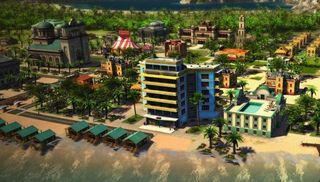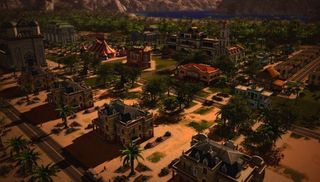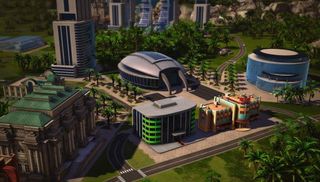Tropico 5 first-look: become a dictator and build a despotic dynasty in this reformist sequel

They say that power corrupts, but I suspect it also ages. A once freshfaced candidate, swept into office on an upswell of hope and enthusiasm, will inevitably leave as a wearied, greying husk. In that sense, Tropico 4 was the outgoing incumbent.
The last game in the politically parodic city-building series didn't introduce new ideas, it merely provided additions to existing features. It brought more buildings, more edicts and more superpowers for El Presidente to deal with, but the telltale tiredness was starting to show. To rejuvenate the franchise its developers, Haemimont Games, were in need of a systemic revolution.
Tropico 5 feels like that revolution. It's still built on the same foundation, but massively expands and develops the infrastructure of the game. Throughout the demonstration I was given of the preview build, producer Bisser Dyankov showed off the variety of situations and problems that players might face.
It's a sign that the team recognise one of the limitations of their previous games. While sandbox construction is usually thought of as the heart of city-building sims, earlier Tropicos were designed around scripted missions. When left to their own devices, players could all too easily settle into a comfortable routine, regularly deploying the same handful of tricks to ensure the smooth running of their island. While Tropico 5 will still feature a campaign, the real focus is on that sandbox. Haemimont want to unsettle dictatorial rulers through dynamic events designed to prevent them falling back on tried and tested solutions.

The most obvious example is in the challenges thrown up by the game's four eras. The series is no longer trapped in an indefinite Cold War. Instead, players progress in stages through to the 21st century. Each time period has not only a different architectural sensibility, but a distinct set of goals to meet. In the colonial era—Tropico 5's starting point—you're not the island's glorious leader, but a governor appointed by the crown. Here you extend your stay in power through shows of loyalty to the motherland, rather than through elections (or election fraud).
That loyalty is feigned. You leave the colonial period by declaring your nation's independence, which means your real goal is to prepare for that separation from your imperialist masters. The challenge is to balance outward obedience with internal rebellion, reaping the benefits from the tropical commission while laying the groundwork for solo rule. Naturally, your colonial overseers will be unhappy about this act of secession when it comes. Survival depends on the readiness of an island's military, and the stability of its economy.
As an example of the choices players must make, Dyankov showed me an early event completion screen. Throughout the game, factions and rulers will ask you to perform certain actions. In this instance, a specific building was requested to help boost the island's ability to harvest raw materials, thus increasing its economic growth. As a reward for following orders, the governor's mandate – his ticking clock of time in power – was extended, and an extra boon offered. The issue became whether to choose an additional number of immigrants, a deposit in the island's treasury, a further mandate extension, or to make a donation to the governor's Swiss bank account. All are desirable: the player's choice will serve to determine which shortfalls will need correcting further down the line.
The biggest gaming news, reviews and hardware deals
Keep up to date with the most important stories and the best deals, as picked by the PC Gamer team.

Even here, there are further considerations in the long term. Immigration will be a key factor during the early game, as new workers for your industries are in short supply. But while the promise of growing your population is appealing, any new citizens will be of the royalist faction – loyal to the crown, and thus damaging to your attempt at independence.
While each era has a distinct set of goals and considerations, they combine to form a continuous timeline for your city. By the time you get to the modern era, an island's history is written into everything from its layout to its architectural variety. A stately colonial mansion might border a block of mid-20th-century concrete tenements, both in the shadow of looming modern skyscrapers. It's not simply an aesthetic touch, but also a question of efficiency, cost, infrastructure and resources.
Many buildings can be upgraded over time, provided players unlock the relevant technology through the new research system. Improve a farm, and the large fields requiring manual labour are replaced with a more efficient and more compact greenhouse. As always, there's a downside to the reduced real-estate. High-tech buildings require both electricity and skilled workers, which means the effort to get them running may outweigh the benefits.

Phil has been writing for PC Gamer for nearly a decade, starting out as a freelance writer covering everything from free games to MMOs. He eventually joined full-time as a news writer, before moving to the magazine to review immersive sims, RPGs and Hitman games. Now he leads PC Gamer's UK team, but still sometimes finds the time to write about his ongoing obsessions with Destiny 2, GTA Online and Apex Legends. When he's not levelling up battle passes, he's checking out the latest tactics game or dipping back into Guild Wars 2. He's largely responsible for the whole Tub Geralt thing, but still isn't sorry.
Most Popular


